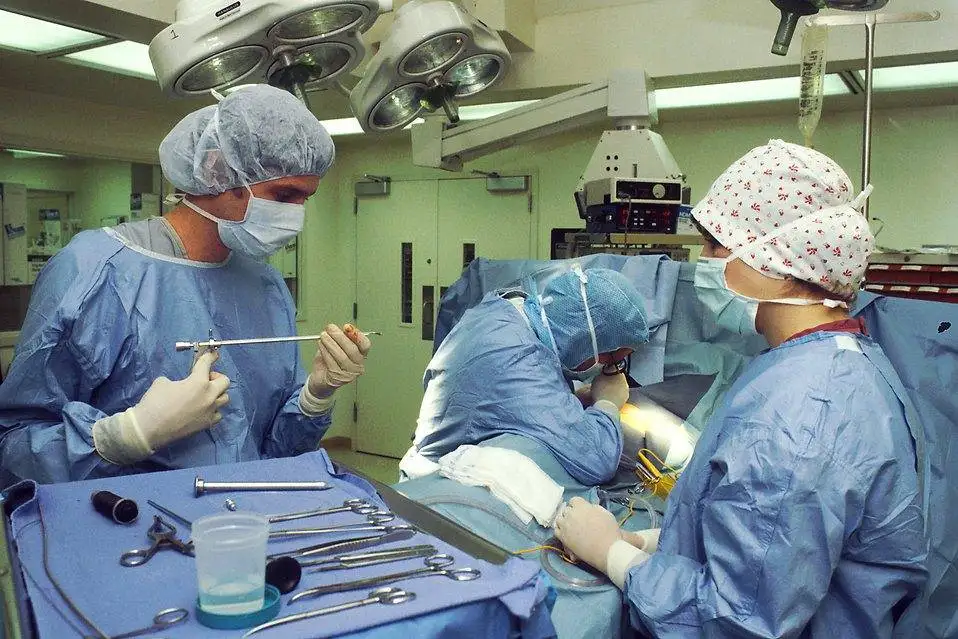Welcoming a newborn into the world is one of life’s most joyful moments. Parents eagerly anticipate those first cries, tiny fingers grasping theirs, and all the “firsts” that come with a new life. But sometimes, the unexpected happens, and instead of pure joy, parents are faced with serious medical concerns.
One such situation is when a baby is born with a rare congenital condition called an imperforate anus. Commonly referred to as “a newborn baby without anus,” it can be overwhelming for any parent, but understanding the condition and the treatment steps can help navigate this challenging situation with greater confidence and hope.
What Is an Imperforate Anus?
An imperforate anus is a congenital malformation in which a baby is born without a normal opening, either missing or blocked, to the anus. In other words, the rectum, the final section of the large intestines, doesn’t connect properly to the outside of the body.
Commonly referred to as a newborn baby without anus, the imperforate anus is part of a broader category of conditions known as anorectal malformations, which affect the structure of the rectum and anus. The condition varies in presentation, from mild to severe, and understanding is crucial to determining the best treatment approach.
- Low-Type Imperforate Anus: The rectum is positioned close to the surface of the skin, but the anal opening is either absent or located in an abnormal position. There may be a small, underdeveloped opening that isn’t large enough to allow stool to pass properly. This is generally easier to correct surgically and has a better long-term prognosis regarding bowel control.
- High-Type Imperforate Anus: The rectum is positioned higher in the pelvis, farther away from where the anus should be. The rectum is not connected to the skin and other structures, such as the urinary or reproductive systems, through a fistula (an abnormal passage). This requires complex surgical intervention and a temporary colostomy before the final surgery is performed.
Why Does It Happen?
The exact cause of an imperforate anus isn’t fully understood, but it’s believed to result from a disruption during the early stages of fetal development when the digestive system forms. Researchers believe that a combination of genetic and environmental factors are contributing factors.
In most cases, there’s no specific known cause, and it occurs sporadically without any family history.
How Common Is Imperforate Anus?
Imperforate anus is relatively rare, affecting about 1 in every 5,000 live births. Although it occurs in boys and girls, studies have shown it’s more common in males. Despite its rarity, it’s a condition that requires prompt and careful medical attention to ensure the best outcomes for the affected child.
Although uncommon, this is one of the more frequent congenital anorectal malformations.
Newborn Baby Without Anus: The Signs and Symptoms
Imperforate anus is identified shortly after birth during the newborn’s first physical examination. However, some signs are more subtle, and parents should know what to look for, especially if the condition is not immediately diagnosed.
- Absence of a Normal Anal Opening: The lack of a visible anal opening in the baby’s bottom is the most obvious sign.
- Failure to Pass Meconium: Newborns pass their first stool, meconium, within 24-48 hours of life. If your baby hasn’t passed meconium within this timeframe, it could indicate a problem with the anus or rectum, such as an imperforate anus.
- Abdominal Distension: If the baby cannot pass stool, the abdomen becomes swollen or distended due to the buildup of waste in the intestines.
- Vomiting: The baby may start vomiting, which signals the intestines are blocked and that stool is backing up into the stomach.
- Unusual Perineal Anatomy: The area between the genitals and the rectum, known as the perineum, appears different or underdeveloped. There’s a small dimple or an abnormal opening in this area, anorectal malformation.
How Is Imperforate Anus Diagnosed?
The diagnosis of an imperforate anus is usually straightforward, as it can often be identified through a physical examination of the newborn. However, additional tests are necessary to determine the type and severity and to check for any associated abnormalities.

Initial Physical Examination: The first step in diagnosing an imperforate anus is a careful physical examination conducted shortly after birth. The healthcare provider will inspect the baby’s perineal area to determine whether a normal anal opening is present. They will also assess the baby for signs of abdominal swelling or other physical anomalies that could suggest additional complications.
Imaging Studies: If the initial examination raises concerns, imaging studies such as X-rays, ultrasound, or magnetic resonance imaging (MRI) may be ordered. These tests help to visualize the position of the rectum, determine whether a fistula is present, and identify any other associated malformations. X-rays taken with the baby in different positions can show where the rectum ends and how close it is to the skin surface, which is crucial information for planning surgery.
Other Diagnostic Tests
Because imperforate anus is often associated with other congenital anomalies, particularly those affecting the urinary tract, spine, and heart, further tests may be recommended. These can include:
- Spinal Ultrasound or MRI: To check for spinal cord abnormalities such as tethered cord syndrome, which is sometimes associated with anorectal malformations.
- Echocardiogram: An ultrasound of the heart to look for congenital heart defects that may be present alongside the anorectal malformation.
- Voiding Cystourethrogram (VCUG): A test that examines the urinary system to check for abnormal connections between the rectum and urinary tract.
Treatment Options for Newborn Baby Without Anus: Surgical Interventions
The treatment for an imperforate anus is surgical, and the specific approach depends on the type of imperforate anus your baby has and whether there are any associated conditions. The goal of surgery is to create a functional anus that allows normal bowel movements and to correct any associated abnormalities.
For Low-Type Imperforate Anus
In cases of low-type imperforate anus, surgery is often performed within the first few days of life. The procedure typically involves creating or widening the anal opening to allow stool to pass through the rectum and anus. The surgeon may also need to reposition the rectum if it is slightly out of place. Because the rectum is close to the skin surface, this surgery is usually less complex and has a good prognosis for bowel control.
For High-Type Imperforate Anus
High-type imperforate anus requires a more complex surgical approach. Often, the first step is to perform a colostomy. In a colostomy, the end of the large intestine is brought through an opening in the abdominal wall, allowing stool to pass into a colostomy bag. This procedure helps relieve pressure and prevents complications while the baby grows and the final surgery is planned.
The definitive surgery, known as posterior sagittal anorectoplasty (PSARP), is usually performed a few months later. During this surgery, the surgeon will carefully dissect through the tissues to locate the end of the rectum and create a new anal opening in the correct position. The rectum is then pulled through this new opening and connected to the skin, creating a functional anus.
Post-Surgical Care and Recovery
After surgery, the baby will need close monitoring in the hospital to ensure proper healing and to manage any complications. Parents will be taught to care for the colostomy site and change the bag. Pain management, careful wound care, and feeding support are also crucial during this period.
Once the definitive surgery is completed and the colostomy is reversed, the focus will shift to ensuring that the baby’s bowel movements are regular and that there are no issues with bowel control. Some children may need to be on a special diet or use laxatives to prevent constipation and ensure smooth bowel movements.
Associated Conditions and Long-Term Considerations
Children with imperforate anus often have other congenital anomalies, and managing these associated conditions is a key part of long-term care. Understanding the potential complications and long-term outlook can help parents prepare for the journey.
Commonly Associated Conditions
- VACTERL Association: Imperforate anus is often part of a spectrum of anomalies known as VACTERL association. This acronym stands for Vertebral anomalies, Anal atresia, Cardiac defects, Tracheo-Esophageal fistula, Renal anomalies, and Limb abnormalities. If your child has an imperforate anus, the healthcare team will likely screen for these other conditions.
- Spinal Cord Abnormalities: Spinal cord problems, such as tethered cord syndrome or sacral agenesis, are sometimes associated with imperforate anus. These conditions can affect a child’s ability to walk, control their bladder, or have bowel movements.
- Urinary Tract Anomalies: Abnormal connections between the rectum and the urinary system (recto-urinary fistulas) can lead to urinary tract infections or issues with bladder control. Ongoing urological care may be necessary to manage these complications.
Bowel Control and Management
Long-term bowel control is a major concern for children with an imperforate anus. The prognosis varies depending on the type of imperforate anus and the success of the surgery. Many children with a low-type imperforate anus achieve normal or near-normal bowel control after surgery. However, those with a high-type imperforate anus may face challenges such as chronic constipation, fecal incontinence, or difficulty sensing the need to pass stool.
Strategies for Managing Bowel Function
- Dietary Modifications: A diet high in fiber and fluids can help prevent constipation and promote regular bowel movements.
- Medications: Laxatives, stool softeners, or enemas may be needed to help manage bowel function. These can be used on a short-term or long-term basis.
- Bowel Management Programs: Some children benefit from a structured bowel management program, which includes scheduled bowel movements, enemas, and medications to help maintain regularity and prevent accidents.
Medical Follow-Ups
Children with an imperforate anus will need regular follow-up with a pediatric surgeon, gastroenterologist, and possibly a urologist or nephrologist if there are associated urinary tract issues. Regular check-ups help monitor bowel function, detect complications early, and adjust the treatment plan.
Emotional and Psychological Support for Families
Caring for a child with an imperforate anus can be emotionally challenging for parents. The condition, while treatable, involves a series of medical interventions, surgeries, and ongoing care that could be stressful and overwhelming. Parents need to seek emotional and psychological support as they navigate this journey.
- Build a Support Network: Create a support network of family, friends, and healthcare professionals. Connect with other parents with children with similar conditions who can provide valuable insights, encouragement, and understanding. Support groups, in-person and online, are a great resource for sharing experiences and advice.
- Communicate with Your Healthcare Team: Maintain open and clear communication with your child’s healthcare team. Don’t hesitate to ask questions, seek clarification, or express concerns about your child’s condition or treatment. Understand the condition and treatment plan to alleviate anxiety and feel more in control.
- Coping with Stress and Uncertainty: The emotional toll of caring for a child with a complex medical condition is significant. Parents should recognize when they need help and seek resources such as counseling or therapy. Mental health professionals offer strategies for managing stress, anxiety, and depression and provide a safe space to express feelings and fears.
Newborn Baby Without Anus: Look Ahead with Optimism
With a newborn baby without anus, a diagnosis of imperforate anus, is challenging and unexpected. With early diagnosis, appropriate surgical intervention, and medical care, most children go on to lead healthy, active lives. The road to recovery involves multiple surgeries and long-term management.
Advances in pediatric surgery have made it possible for many children with imperforate anus to achieve good bowel function and quality of life. As you navigate this journey, you aren’t alone. Lean on your healthcare team, connect with other families, and seek support when needed.
With the right care and support, you provide your child with the best possible start and look forward with hope and optimism. For more information and guidance on caring for your child’s health, visit Omegapediatrics. They offer resources to help you understand and manage your child’s health condition.
- Fractures: A Comprehensive Guide to Broken Bones in Children
- Newborn Care: Tips from a Pediatrician to Keep Baby Healthy and Happy
These articles provide additional insights and practical advice for parents facing similar challenges.






